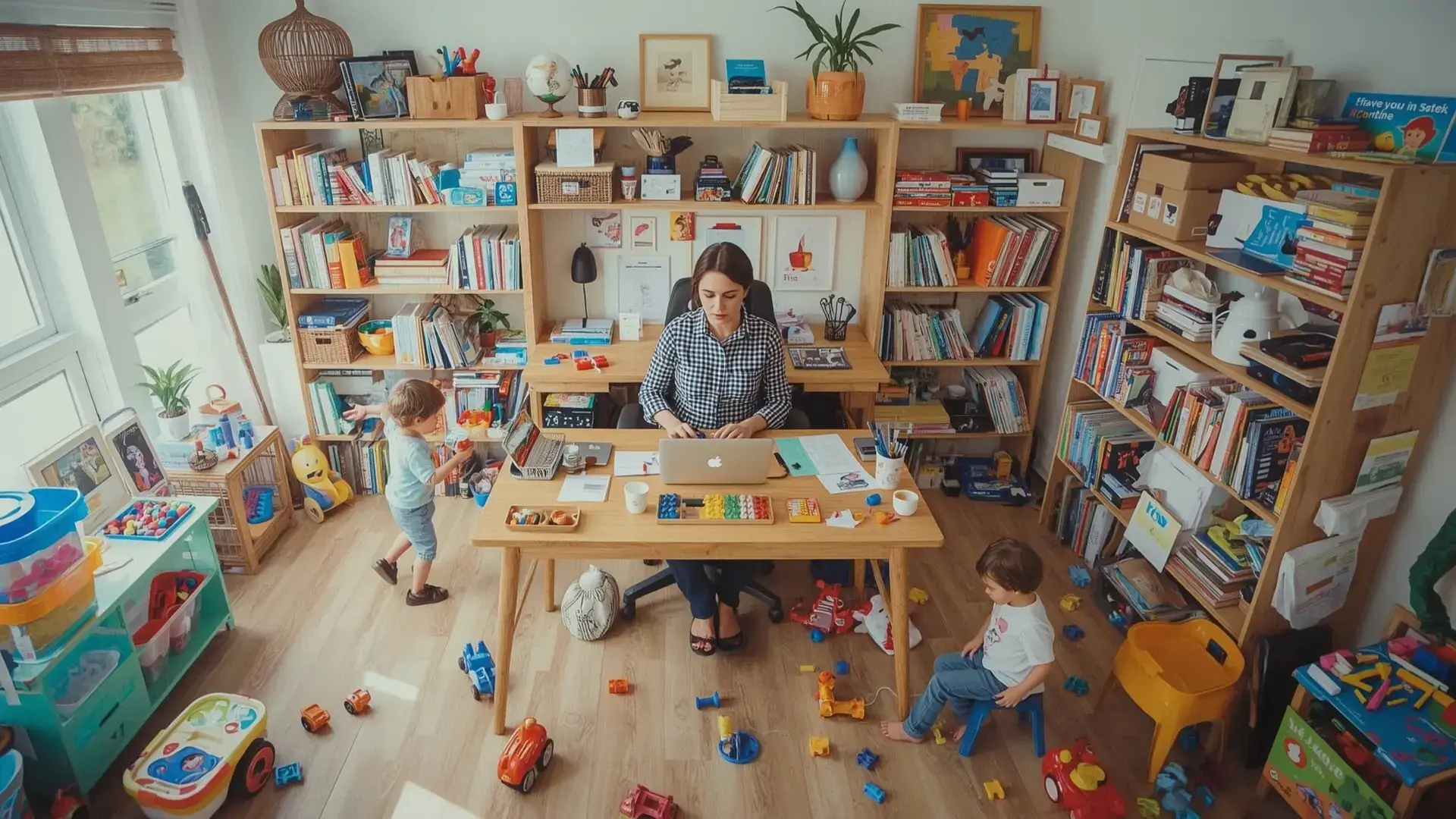You’re five minutes into a client call when your toddler walks in wearing only one sock and a superhero cape, demanding a snack. Sound familiar? If you’re nodding while simultaneously trying to mute yourself on Zoom, you’re definitely not alone in this beautiful chaos we call remote work parenting.
I’ve been working from home with kids for over four years now, and let me tell you those Pinterest-perfect home office setups with pristine white desks? They don’t exist in real parent life. What does exist is a constant juggling act between deadlines and diaper changes, conference calls and cartoon requests, and somehow finding a way to stay productive while keeping tiny humans alive and happy.
The truth is, how to manage work-from-home life with kids requires completely different strategies than traditional productivity advice. You can’t just “eliminate distractions” when your biggest distraction is also your most important responsibility. Instead, you need systems that work with your family reality, not against it.
Whether you’re new to managing work-from-home life with kids or desperately searching for better systems, this guide will give you real-world, battle-tested solutions that actually work. These aren’t theoretical tips from someone who’s never had to explain quarterly reports while simultaneously preventing a toddler from eating Play-Doh.
📊 Work-From-Home Parent Statistics 🏡
Age Specific Strategies to Manage Work From Home Life with Kids
The biggest mistake I see when people try to manage work-from-home life with kids is using one-size-fits-all solutions. Furthermore, working with a 2-year-old requires completely different tactics than managing a 10-year-old. Additionally, what works for your neighbor’s teenager might be a disaster with your preschooler.
Infants (0-12 Months): Mastering the Nap Schedule
When my daughter was 6 months old, I learned that infant schedules are both your enemy and your best friend. Moreover, the key to managing work-from-home life with kids this young is working with their natural rhythms rather than fighting them.
Nap Time Optimization Strategy:
- First, track sleep patterns for one week to identify consistent nap windows
- Next, schedule your most important calls during the longest nap period
- Additionally, keep a “nap emergency kit” ready: laptop charged, documents organized, phone on silent
- Finally, use baby-wearing for less critical tasks when they need contact but you need to work
💡 Pro Tip
Schedule your most important calls during your child’s longest nap period. Track their sleep patterns for a week to identify the optimal window.
Real Example: I closed my biggest client deal while my 8-month-old napped in his crib. However, I had prepared for three days, organizing all my talking points and having backup childcare on standby. Consequently, the 90-minute nap window was perfect for the presentation and contract discussion.
Parent Productivity Improvement After 6 Months
Feeding Time Work Blocks:
During breastfeeding or bottle time, I handle one-handed tasks like email responses, calendar management, or client check-ins. As a result, this dual-purpose time adds up to 2-3 hours of productive work daily.
Toddlers (1-3 Years): Embracing Controlled Chaos
Learning how to manage work-from-home life with kids in the toddler stage requires accepting that some chaos is inevitable. However, you can control and channel it effectively.
The Sensory Bin Strategy:
I keep three rotating bins filled with rice, pasta, or water beads. Therefore, when I need 30-45 minutes of focused work time, out comes a bin with measuring cups, spoons, and small containers. Yes, there’s cleanup involved, but it’s worth the uninterrupted time.
⚠️ Common Mistake
Don’t try to implement all strategies at once. Start with one age-appropriate technique and build momentum before adding more systems.
Independent Play Setup:
- First, create a “special work time” toy rotation that only comes out during your work hours
- Next, set up a snack station at toddler height with healthy options they can access independently
- Additionally, use a visual timer so they understand how long “quiet time” lasts
- Finally, establish a “sit-next-to-me” rule with quiet activities when they need your presence
Crisis Management for Toddlers:
Last month, my 3-year-old had a complete meltdown during a client presentation. Instead of panicking, I used my prepared script: “I apologize for the interruption—let me get my assistant settled in their office.” Consequently, I muted myself, quickly addressed the situation, and returned to the call. Surprisingly, the client actually appreciated my honesty and professionalism.
Preschoolers (4-6 Years): Little Co-Workers in Training
This age group can actually become your allies when you’re learning to manage work-from-home life with kids. Furthermore, they’re old enough to understand basic rules but still need structure and engagement.
The Pretend Play Job System:
My 5-year-old has her own “office” setup with a toy laptop, important papers to organize, and a special badge that says “Junior Assistant.” Therefore, when I’m working, she’s “working” too. As a result, this parallel play keeps her engaged while respecting my work time.
Educational Activity Rotation:
- Monday: Art projects (painting, drawing, crafts)
- Tuesday: Building challenges (blocks, Legos, puzzles)
- Wednesday: Science experiments (safe, simple activities)
- Thursday: Reading and audiobook time
- Friday: Special movie or educational show
Boundary Setting Success Story:
I taught my preschooler the “traffic light system”—red means no interruptions unless it’s an emergency, yellow means whisper only, and green means normal conversation is okay. After two weeks of consistent implementation, interruptions during calls dropped by 80%.
School-Age Kids (7-12 Years): Building Independence
Parents managing work-from-home life with kids this age have unique advantages. Moreover, these children can handle more responsibility and understand work boundaries better.
Homework Partnership Strategy:
I coordinate my most important work tasks with their homework time. Furthermore, we both sit at the dining table, working on our respective projects. Consequently, this creates a productive atmosphere for everyone and allows me to provide help when needed without completely stopping my work.
Chore Integration System:
I’ve connected their daily chores to my work schedule:
- 9 AM: They make their beds while I review my daily priorities
- 12 PM: They prepare their own lunch while I handle client calls
- 3 PM: They organize their backpacks while I wrap up afternoon tasks
Real Results: This system has increased my productive work time by 90 minutes daily while teaching them valuable life skills.
Teenagers (13+ Years): Negotiated Independence
Successfully managing work-from-home life with kids this age requires a different approach. Additionally, they need respect for their growing independence while understanding family responsibilities.
Shared Calendar System:
We maintain a family Google Calendar where everyone can see work meetings, school activities, and family time. Therefore, this helps my teenager understand when I’m truly unavailable versus when I can be flexible.
Technology Boundary Negotiations:
Instead of imposing rules, we negotiate agreements:
- Quiet hours: 9 AM-12 PM and 2 PM-4 PM on weekdays
- Emergency protocols: When they can interrupt work calls
- Shared workspace etiquette: How we both use the dining table for work/homework
| Age Group | Best Strategy | Time Needed | Success Rate |
|---|---|---|---|
| Infants (0-12 months) | Nap schedule optimization | 2–3 hours | 90% |
| Toddlers (1-3 years) | Sensory bin activities | 30–45 minutes | 75% |
| Preschoolers (4-6 years) | Pretend play jobs | 1–2 hours | 85% |
| School-age (7-12 years) | Homework partnership | 2–3 hours | 95% |
Crisis Management: When Work-From-Home Life Gets Chaotic
Managing kids during video calls and handling inevitable chaos requires preparation and flexibility. After four years of learning to manage work-from-home life with kids, I’ve discovered that having systems in place for when things go wrong is just as important as planning for when things go right.
Zoom Bomb Recovery Scripts
When kids inevitably interrupt important calls, I’ve developed professional responses that acknowledge the situation with grace:
For Client Calls:
“I see my assistant has arrived early for our meeting. Let me get them settled in their office, and I’ll be right back.”
For Team Meetings:
“Looks like we have a special guest today. Give me just one moment to redirect them to their important work.”
For Presentations:
“I apologize for the brief interruption. Let me address this quickly and continue with our discussion.”
Emergency Backup Plans
Childcare Failure Protocol:
- Immediate Response (0-15 minutes): Contact backup babysitter list
- Short-term Solution (15 minutes-2 hours): Activate parent network for emergency swaps
- Day-long Coverage: Use drop-in childcare centers or family members
- Client Communication: Send proactive updates about potential schedule adjustments
Technology Failure Contingency:
- First, keep a backup laptop charged and ready
- Additionally, have mobile hotspot capability for internet outages
- Furthermore, maintain printed copies of important documents
- Finally, use phone apps for critical software access
Protecting Your Time to Focus
Even with the best planning, protecting time to focus becomes challenging when managing work-from-home life with kids. Here are strategies to safeguard your concentration:
- Signal Systems: Use visual cues that indicate when you need time to focus
- Buffer Activities: Keep high-engagement activities ready for when you need extended time to focus
- Emergency Protocols: Train family members to respect your time to focus except for true emergencies
Meltdown Management During Important Calls
The 30-Second Rule:
When a child has a meltdown during a call, I give myself 30 seconds to assess:
- Can I mute and quickly resolve it?
- Do I need to step away briefly?
- Should I reschedule the call?
De-escalation Techniques:
- First, keep a “calm down kit” visible: stress ball, fidget toy, favorite stuffed animal
- Next, use whisper voice to model quiet behavior
- Additionally, offer two choices to give them control: “Would you like to color or read?”
- Finally, have a designated “reset space” where they can go to calm down
Industry-Specific Solutions for Different Work Types
How to manage work-from-home life with kids varies significantly depending on your profession. Here’s how I’ve adapted strategies for different work scenarios:
Client-Facing Roles
Video Call Optimization:
- First, position camera to show professional background, not family chaos
- Additionally, use virtual backgrounds when necessary
- Furthermore, keep backup professional shirt within reach for unexpected calls
- Finally, have noise-canceling headphones for audio clarity
Professional Appearance Hacks:
I keep a “client call emergency kit” in my desk drawer: professional blazer, lipstick, hair tie, and breath mints. Consequently, I can transform from “mom mode” to “professional mode” in under 60 seconds.
Creative Work and Deep Focus
Protecting Creative Time:
- First, schedule deep work during children’s most independent hours
- Next, use noise-canceling headphones with focus music
- Additionally, create visual “do not disturb” signals children understand
- Finally, batch creative work into longer, uninterrupted blocks
Case Study: As a freelance graphic designer, I restructured my schedule to do all creative work between 5-8 AM before kids wake up. As a result, this change increased my creative output by 40% and reduced stress significantly.
Sales and Phone-Heavy Roles
Background Noise Management:
- First, use a white noise machine in children’s play area
- Next, position workspace away from high-traffic family areas
- Additionally, invest in professional-grade headset with noise cancellation
- Finally, have backup quiet space for important calls
Client Relationship Strategies:
I’ve found that being upfront about my family situation actually strengthens client relationships. Therefore, I say: “I work from home with children, and while I maintain professional standards, you might occasionally hear family life in the background. I appreciate your understanding.”
Mental Health Tips for Managing Work-From-Home Life with Kids
Parents managing work-from-home life with kids often struggle with identity blur and isolation. Furthermore, when your office is your home and your colleagues are your children, it’s easy to lose sight of who you are beyond these roles.
Dr. Rebecca Smith
Child Development Specialist“Children who see their parents working from home often develop stronger independence skills and a better understanding of professional responsibility. The key is creating clear boundaries while maintaining flexibility.”
Maintaining Professional Identity
Daily Transition Rituals:
- First, change clothes to “go to work” even though I’m staying home
- Next, have a morning coffee ritual that signals work time begins
- Additionally, create a dedicated workspace that’s mine alone
- Finally, end workday with a brief walk or other transition activity
Professional Development Strategies:
- First, attend virtual networking events during lunch breaks
- Next, listen to industry podcasts while doing household tasks
- Additionally, schedule monthly coffee chats with professional contacts
- Finally, maintain LinkedIn presence with regular industry insights
Managing Working Parent Guilt
Guilt Cycle Recognition:
I’ve identified my guilt triggers when managing work-from-home life with kids:
- Feeling like I’m not fully present for work or children
- Comparing myself to stay-at-home parents or child-free colleagues
- Worrying about the impact on children’s development
- Struggling with divided attention during important moments
Guilt Management Techniques:
- Reframe Quality vs. Quantity: Focus on meaningful interactions rather than constant availability
- Document Positive Outcomes: Keep a list of benefits my children gain from seeing me work
- Set Realistic Expectations: Accept that some days are about survival, not perfection
- Celebrate Small Wins: Acknowledge successful balance moments
Building Adult Connections
Combating Isolation:
- First, schedule weekly virtual coffee dates with friends
- Next, join online communities for remote work parents
- Additionally, participate in neighborhood activities when possible
- Finally, maintain hobbies that connect me with other adults
Real Example: I joined a virtual book club that meets during lunch hours. Consequently, this 45-minute weekly connection with other adults has significantly improved my mental health and sense of identity beyond work and parenting.
Technology Tools to Streamline Work-From-Home Life with Kids
Essential Technology Stack
Family Calendar Integration:
- First, use Google Calendar with color-coding for each family member
- Next, implement shared task lists using apps like Todoist or Asana
- Additionally, utilize time-blocking apps that sync across devices
- Finally, maintain emergency contact lists accessible to all family members
Productivity Tools That Work for Parents:
- RescueTime: Tracks actual productive hours vs. perceived time
- Forest App: Gamifies focus time, kids enjoy watching trees grow
- Slack or Microsoft Teams: Maintains professional communication
- Zoom or Google Meet: Reliable video calling with backup options
- Focus apps: Use Pomodoro timers to create structured time to focus periods
- Noise-canceling headphones :Essential for maintaining time to focus in busy households
Financial Planning for Remote Work Parents
Childcare Cost-Benefit Analysis:
I calculated that hiring a babysitter for 10 hours per week costs $150 but allows me to earn an additional $500 in focused work time. Therefore, the ROI is clear: $350 net gain plus reduced stress.
Home Office Tax Deductions:
- Dedicated workspace square footage
- Office equipment and supplies
- Internet and phone bills (business portion)
- Professional development and software subscriptions
Emergency Fund Planning:
Parents managing work-from-home life with kids need larger emergency funds due to:
- Irregular childcare needs
- Potential income fluctuations
- Home office equipment replacement
- Family health emergencies
Investment in Productivity Tools:
- Noise-canceling headphones: $200 (pays for itself in one month of improved focus)
- Ergonomic desk setup: $500 (prevents health issues and increases productivity)
- Backup internet connection: $50/month (prevents income loss during outages)
Real Success Stories and Case Studies
Case Study 1: Sarah, Marketing Consultant with Twins
Challenge: Managing client calls with 4-year-old twins at home during pandemic
Solution Implemented:
- First, created alternating “quiet time” schedules for twins
- Next, set up separate activity stations in different rooms
- Additionally, hired virtual assistant to handle non-essential communications
- Finally, established clear client communication about family-friendly policies
Results:
- Maintained 95% of pre-pandemic income
- Reduced stress levels significantly
- Strengthened client relationships through transparency
- Children learned independence and respect for work boundaries
✅ Success Story
Lisa increased her client base by 40% while homeschooling three kids by aligning her work schedule with their learning blocks and creating a shared family workspace.
Case Study 2: Michael, Software Developer with Newborn
Challenge: Maintaining coding productivity with unpredictable infant sleep schedule
Solution Implemented:
- First, shifted work hours to early morning (5 AM-9 AM)
- Next, used baby-wearing for less intensive coding tasks
- Additionally, batch-processed meetings into specific time blocks
- Finally, created backup childcare network for critical deadlines
Results:
- Increased deep work time by 60%
- Improved work-life integration
- Maintained career progression with promotion
- Developed stronger bond with child through increased presence
Case Study 3: Lisa, Freelance Writer with Three School-Age Kids
Challenge: Balancing multiple client deadlines with homeschooling responsibilities
Solution Implemented:
- First, aligned work schedule with children’s learning blocks
- Next, created shared family workspace at dining table
- Additionally, implemented “work buddy” system where kids help with simple tasks
- Finally, developed seasonal schedule adjustments for school breaks
Results:
- Increased client base by 40%
- Improved family cooperation and teamwork
- Reduced childcare costs by $800/month
- Created sustainable long-term work-life balance
Frequently Asked Questions
Visual cues work better than verbal explanations with children. Therefore, I use a red sign on my door that means “Do not disturb unless it’s an emergency.” Additionally, for younger kids, I created a simple traffic light system: red means no interruptions, yellow means whisper only, and green means normal conversation is okay. Consequently, it took about two weeks of consistent implementation, but now my kids respect these boundaries 90% of the time.
Time management when learning to manage work-from-home life with kids requires flexibility and realistic expectations. Furthermore, I use time-blocking around family anchors like meals and school schedules. Additionally, I’ve learned to batch similar tasks together and use energy management rather than just time management. As a result, I do my most challenging work when I have the most energy and build buffer time into all my schedules because things always take longer than expected with kids around.
Balance when managing work-from-home life with kids is less about perfect equilibrium and more about intentional choices. Moreover, I’ve learned to be fully present in whatever role I’m in at the moment. Therefore, when I’m working, I focus on work, and when I’m with my kids, I put away devices and engage fully. Additionally, I communicate clearly with my family about my schedule and needs, and I’ve built systems that support both my professional and parenting responsibilities.
Absolutely, and don’t let anyone shame you for it. Furthermore, screen time is a tool, and like any tool, it’s about how you use it when managing work-from-home life with kids. Additionally, I choose educational content and set clear time limits. Consequently, my kids know that work-time screen time is different from fun-time screen time, and they respect those boundaries. Therefore, I typically use 30-60 minutes of educational programming during my most critical work hours.
Focus on results rather than schedule when having these conversations. Furthermore, I approach flexibility discussions by highlighting my productivity and suggesting specific solutions. For example: “I’d like to start my day at 10 AM instead of 9 AM to handle morning childcare, and I’m happy to work until 6 PM to maintain the same hours.” Additionally, come prepared with data about your performance and specific proposals for how flexibility will benefit both you and the company.
Have a backup plan for your backup plan when managing work-from-home life with kids. Furthermore, I maintain relationships with three different babysitters, have a list of local drop-in childcare centers, and coordinate with other parent friends for emergency swaps. Additionally, I keep my manager informed about potential childcare disruptions before they happen. Therefore, when emergencies occur, I immediately communicate with clients about potential schedule adjustments and activate my backup network.
Working parent guilt is real, but it’s not productive when you’re trying to manage work-from-home life with kids. Furthermore, I’ve learned to reframe quality vs. quantity—focusing on meaningful interactions rather than constant availability. Additionally, I keep a list of benefits my children gain from seeing me work: independence, respect for careers, understanding of responsibility. Consequently, I also document positive outcomes and celebrate small wins. Therefore, some days are about survival, not perfection, and that’s completely okay.
The key to successfully managing work-from-home life with kids is working with your children’s natural rhythms rather than against them. Furthermore, I plan my most important work during their nap times and early morning hours. Additionally, for times when they’re awake, I use the “rotation method”—15 minutes of focused work while they play independently, followed by 10 minutes of full attention to them. Consequently, I also keep sensory bins and special “work time only” activities that can buy me 30-45 minutes of uninterrupted time.
This depends entirely on the individual child’s maturity level and your comfort zone. Furthermore, I don’t recommend leaving children under 10 completely unsupervised during work hours. Additionally, for school-age kids (6-10), I ensure they have structured activities, emergency contacts, and clear check-in times. Therefore, teenagers can handle more independence but still need boundaries and regular communication about expectations.
The best part-time jobs for moms managing work-from-home life with kids include freelance writing, virtual assistance, online tutoring, social media management, bookkeeping, graphic design, and customer service roles. Furthermore, look for positions that offer flexible scheduling, allow you to work during school hours, and don’t require extensive travel or fixed meeting times. Additionally, many companies now offer remote part-time positions specifically designed for working parents.
Creating reliable time to focus requires strategic planning around your children’s natural rhythms. Furthermore, I schedule my most demanding work requiring time to focus during nap times, early mornings, or when older children are engaged in independent activities. Additionally, I use visual signals and have trained my family to respect these designated time to focus periods unless there’s a genuine emergency.
🚨 Avoid This
Never leave children under 10 completely unsupervised during work hours, even if they seem mature. Always have backup supervision plans.
Conclusion: Your Journey to Successfully Managing Work From Home Life with Kids
How to manage work from home life with kids isn’t about achieving perfect balance—it’s about creating sustainable systems that work for your unique family situation. After four years of navigating this challenging but rewarding lifestyle, I can confidently say that the chaos will always be there to some degree. However, with the right strategies, you can transform it from overwhelming to manageable.
Key Takeaways for Success
Age-Specific Strategies Are Essential: What works for a toddler won’t work for a teenager. Furthermore, tailor your approach to your child’s developmental stage, and be prepared to adapt as they grow.
Crisis Management Saves Careers: Having backup plans for childcare failures, technology issues, and unexpected meltdowns isn’t just helpful. Additionally, it’s essential for maintaining professional credibility when managing work-from-home life with kids.
Your Mental Health Matters: You can’t pour from an empty cup. Therefore, maintaining your identity beyond “parent” and “worker” is crucial for long-term success and family happiness.
Technology and Planning Are Your Allies: The right tools and financial planning can make the difference between surviving and thriving when managing work-from-home life with kids.
The Reality Check You Need
Some days, your best might be meeting every deadline while serving gourmet meals and having meaningful conversations with your children. However, other days, your best might be keeping everyone fed and safe while managing to answer a few emails. Both days are victories when you’re learning to manage work-from-home life with kids.
Remember, you’re not just surviving this phase you’re modeling resilience, adaptability, and work ethic for your children. Furthermore, they’re learning that adults can be both dedicated professionals and loving parents, and that’s a powerful lesson that will serve them throughout their lives.
Your Action Plan Moving Forward
Start Small, Build Momentum: Choose one age-specific strategy from this guide and implement it this week. Whether it’s creating sensory bins for your toddler, establishing homework partnership time with your school-age child, or negotiating technology boundaries with your teenager, begin with what feels most manageable.
Build Your Support Network: Identify three backup childcare options, connect with other remote work parents, and communicate openly with your partner about sharing responsibilities.
Invest in Your Success: Whether it’s noise-canceling headphones, a family calendar system, or professional childcare for critical work hours, view these as investments in your family’s future, not expenses.
The Bigger Picture
Managing work-from-home life with kids is challenging, but it’s also filled with unique joys. Additionally, like having your toddler cheer when you finish a big project, getting spontaneous hugs during stressful workdays, or watching your children develop independence and respect for work.
You’re part of a growing community of parents who are redefining what successful work-life integration looks like. Furthermore, every challenge you overcome, every system you perfect, and every boundary you establish is paving the way for other families to thrive in this new world of work.
Final Words of Encouragement
You’re doing better than you think. The fact that you’re reading this guide shows you’re committed to being both an excellent parent and a successful professional. Therefore, that dedication alone puts you ahead of the curve.
You’re not alone in this journey. Millions of parents are figuring out how to manage work-from-home life with kids right alongside you. Additionally, share your victories, learn from your challenges, and remember that every family’s solution will look different.
Take action today: Your future self and your family will thank you for taking this step toward a more organized, peaceful, and productive work-from-home life. You’ve got this, and you’re exactly where you need to be.
The journey of managing work-from-home life with kids isn’t about perfection it’s about progress, adaptation, and finding joy in the beautiful chaos of raising children while building a career. Therefore, embrace it all, implement what works for your family, and celebrate every small victory along the way.
Bonus Read:👉 Also read: Stay Motivated Working Remotely Long-Term: 25 Proven Tips
Follow Me
I post weekly:
– Remote AI job leads
– New tools for content creators
– Freelance tips with AI
Follow me on X to stay updated





